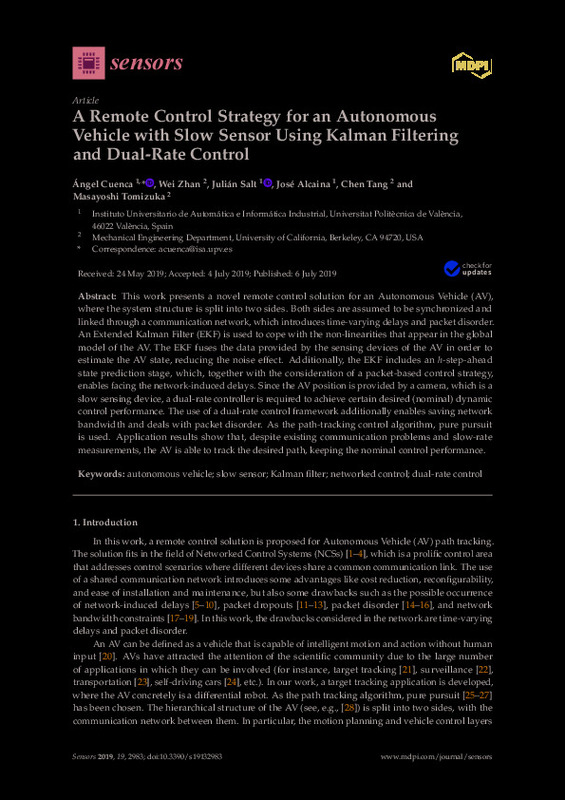JavaScript is disabled for your browser. Some features of this site may not work without it.
Buscar en RiuNet
Listar
Mi cuenta
Estadísticas
Ayuda RiuNet
Admin. UPV
A Remote Control Strategy for an Autonomous Vehicle with Slow Sensor Using Kalman Filtering and Dual-Rate Control
Mostrar el registro sencillo del ítem
Ficheros en el ítem
| dc.contributor.author | Cuenca, Ángel
|
es_ES |
| dc.contributor.author | Zhan, Wei
|
es_ES |
| dc.contributor.author | Salt Llobregat, Julián José
|
es_ES |
| dc.contributor.author | Alcaina-Acosta, José Joaquín
|
es_ES |
| dc.contributor.author | Tang, Chen
|
es_ES |
| dc.contributor.author | Tomizuka, Masayoshi
|
es_ES |
| dc.date.accessioned | 2023-03-30T18:01:14Z | |
| dc.date.available | 2023-03-30T18:01:14Z | |
| dc.date.issued | 2019-07-01 | es_ES |
| dc.identifier.uri | http://hdl.handle.net/10251/192657 | |
| dc.description.abstract | [EN] This work presents a novel remote control solution for an Autonomous Vehicle (AV), where the system structure is split into two sides. Both sides are assumed to be synchronized and linked through a communication network, which introduces time-varying delays and packet disorder. An Extended Kalman Filter (EKF) is used to cope with the non-linearities that appear in the global model of the AV. The EKF fuses the data provided by the sensing devices of the AV in order to estimate the AV state, reducing the noise effect. Additionally, the EKF includes an h-step-ahead state prediction stage, which, together with the consideration of a packet-based control strategy, enables facing the network-induced delays. Since the AV position is provided by a camera, which is a slow sensing device, a dual-rate controller is required to achieve certain desired (nominal) dynamic control performance. The use of a dual-rate control framework additionally enables saving network bandwidth and deals with packet disorder. As the path-tracking control algorithm, pure pursuit is used. Application results show that, despite existing communication problems and slow-rate measurements, the AV is able to track the desired path, keeping the nominal control performance. | es_ES |
| dc.description.sponsorship | This research work has been developed as a result of a mobility stay funded by Spanish Ministry of Education under "Programa Estatal de Promocion del Talento y su Empleabilidad en I+D+i, Subprograma Estatal de Movilidad, del Plan Estatal de Investigacion Cientifica y Tecnica y de Innovacion 2013-2016". In addition, the research was funded in part by Grant RTI2018-096590-B-I00 from the Spanish government and by the European Commission as part of Project H2020-SEC-2016-2017, Topic: SEC-20-BES-2016, ID: 740736, "C2 Advanced Multi-domain Environment and Live Observation Technologies" (CAMELOT). Part WP5 supported by Tekever ASDS, Thales Research and Technology, Viasat Antenna Systems, Universitat Politecnica de Valencia, Fundacao da Faculdade de Ciencias da Universidade de Lisboa, Ministerio da Defensa Nacional, Marinha Portuguesa, and Ministerio da Administracao Interna Guarda Nacional Republicana. | es_ES |
| dc.language | Inglés | es_ES |
| dc.publisher | MDPI AG | es_ES |
| dc.relation.ispartof | Sensors | es_ES |
| dc.rights | Reconocimiento (by) | es_ES |
| dc.subject | Autonomous vehicle | es_ES |
| dc.subject | Slow sensor | es_ES |
| dc.subject | Kalman filter | es_ES |
| dc.subject | Networked control | es_ES |
| dc.subject | Dual-rate control | es_ES |
| dc.subject.classification | INGENIERIA DE SISTEMAS Y AUTOMATICA | es_ES |
| dc.title | A Remote Control Strategy for an Autonomous Vehicle with Slow Sensor Using Kalman Filtering and Dual-Rate Control | es_ES |
| dc.type | Artículo | es_ES |
| dc.identifier.doi | 10.3390/s19132983 | es_ES |
| dc.relation.projectID | info:eu-repo/grantAgreement/AEI/Plan Estatal de Investigación Científica y Técnica y de Innovación 2017-2020/RTI2018-096590-B-I00/ES/DISEÑO EFICIENTE DE SISTEMAS DE CONTROL EN RED INALAMBRICA APLICADOS A UXVS UTILIZANDO TECNICAS DE CONTROL CON MUESTREO NO CONVENCIONAL Y BASADAS EN EVENTOS/ | es_ES |
| dc.relation.projectID | info:eu-repo/grantAgreement/EC/H2020/740736/EU | es_ES |
| dc.rights.accessRights | Abierto | es_ES |
| dc.contributor.affiliation | Universitat Politècnica de València. Escuela Técnica Superior de Ingenieros Industriales - Escola Tècnica Superior d'Enginyers Industrials | es_ES |
| dc.contributor.affiliation | Universitat Politècnica de València. Escuela Técnica Superior de Ingeniería del Diseño - Escola Tècnica Superior d'Enginyeria del Disseny | es_ES |
| dc.description.bibliographicCitation | Cuenca, Á.; Zhan, W.; Salt Llobregat, JJ.; Alcaina-Acosta, JJ.; Tang, C.; Tomizuka, M. (2019). A Remote Control Strategy for an Autonomous Vehicle with Slow Sensor Using Kalman Filtering and Dual-Rate Control. Sensors. 19(13):1-21. https://doi.org/10.3390/s19132983 | es_ES |
| dc.description.accrualMethod | S | es_ES |
| dc.relation.publisherversion | https://doi.org/10.3390/s19132983 | es_ES |
| dc.description.upvformatpinicio | 1 | es_ES |
| dc.description.upvformatpfin | 21 | es_ES |
| dc.type.version | info:eu-repo/semantics/publishedVersion | es_ES |
| dc.description.volume | 19 | es_ES |
| dc.description.issue | 13 | es_ES |
| dc.identifier.eissn | 1424-8220 | es_ES |
| dc.identifier.pmid | 31284562 | es_ES |
| dc.identifier.pmcid | PMC6652128 | es_ES |
| dc.relation.pasarela | S\390937 | es_ES |
| dc.contributor.funder | AGENCIA ESTATAL DE INVESTIGACION | es_ES |
| dc.contributor.funder | COMISION DE LAS COMUNIDADES EUROPEA | es_ES |
| dc.contributor.funder | Universitat Politècnica de València | es_ES |
| dc.contributor.funder | Fundação para a Ciência e a Tecnologia, Portugal | es_ES |








